University of Sussex
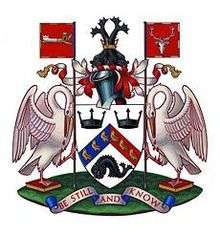 University of Sussex Coat of Arms | |
| Motto | Latin: Vacate et scire |
|---|---|
Motto in English | Be still and know |
| Type | Public |
| Established | 1961 (Royal Charter) |
| Endowment | £9.4 million (2015)[1] |
| Chancellor | Sanjeev Bhaskar |
| Vice-Chancellor | Adam Tickell |
| Visitor | The Lord President of the Council ex officio |
Academic staff | 1075[2] |
Administrative staff | 1207[2] |
| Students | 15,155 (2015/16)[3] |
| Undergraduates | 10,940 (2015/16)[3] |
| Postgraduates | 4,215 (2015/16)[3] |
| Location | Falmer, East Sussex, England |
| Campus | City, Campus, Seaside |
| Colours | White and Flint |
| Affiliations | Universities UK, BUCS, formerly 1994 Group |
| Sports | Rugby, Football, Hockey, Lacrosse, Volleyball |
| Mascot | Badger |
| Website | www.sussex.ac.uk |
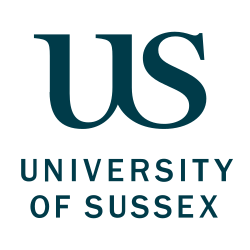 | |
The University of Sussex is a public research university in Falmer, near Brighton in Sussex.[4] The university received its Royal Charter in August 1961,[5] and was a founding member of the 1994 Group of research-intensive universities promoting excellence in research and teaching.
Sussex counts three Nobel Prize winners, 14 Fellows of the Royal Society, six Fellows of the British Academy and a winner of the Crafoord Prize among its faculty. In the latest rankings, the university was placed 62nd in Europe and 140th in the world by the Times Higher Education World University Rankings 2015–16. The Guardian University Guide 2016 placed Sussex 19th in the United Kingdom and the Times and Sunday Times Good University Guide 2016 also ranks Sussex 19th. The 2015 Academic Ranking of World Universities placed the university within the top 18-21 in the United Kingdom and in the top 151-200 internationally.[6]
History
20th century
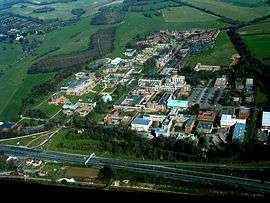
In an effort to establish a university to serve Brighton, a public meeting was held in December 1911 at the Royal Pavilion in order to discover ways to fund the construction of a university; the project was halted by World War I, and the money raised was used instead for books for the Municipal Technical College.
The idea was revived in the 1950s and, in June 1958, the government approved the corporation's scheme for a university at Brighton, to be the first of a new generation of what came to be known as plate glass universities.[5] The University was established as a company in 1959, with a Royal Charter being granted on 16 August 1961.[5] The University's organisation broke new ground in seeing the campus divided into Schools of Study, with students able to benefit from a multidisciplinary teaching environment. Sussex would emphasise cross-disciplinary activity, so that students would emerge from the university with a range of background or 'contextual' knowledge to complement their specialist 'core' skills in a particular subject area.[7]
Sussex came to be identified with student radicalism. In 1973 a mob of students physically prevented United States government adviser Samuel P. Huntington from giving a speech on campus, due to his involvement in the Vietnam War.[8]
21st century
In an attempt to appeal to a modern audience, the university chose in 2004 to cease using its coat of arms[9] and replace it with the "us" logo. The then Vice-Chancellor of the University described the new visual identity as "the starting point for what will be a fresh look and feel for Sussex. It is based on the university's vision and values, themselves a statement of what it aspires to be: pioneering, creative, international, excellent, engaging and challenging."[10]
Campus
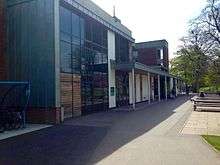
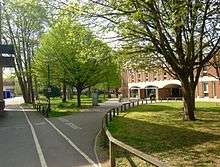
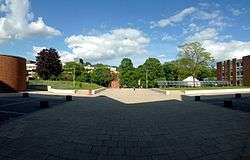
Sussex has been noted to have an attractive location. The university is situated in undulating parkland on the edge of Brighton, and the campus architecture itself has been praised. The campus is surrounded by the South Downs National Park, but relatively close to Brighton, Hove and Lewes.
The campus, designed by Sir Basil Spence, is in the village of Falmer, next to its railway station, and accessed by car from the A27 road. It is situated close to the South Downs, which influenced Spence's design of the campus. The campus is self-contained with facilities and shops.[11]
Spence's designs were appreciated in the architecture community, with many of the buildings on the University's campus winning awards. The gatehouse-inspired Falmer House won a bronze medal from the Royal Institute of British Architects.[5] Another campus building, The Meeting House, won the Civic Trust award in 1969.[12] In 1993, the buildings which made up the core of Spence's designs were given listed building status, with Falmer House being one of only two buildings to be given a Grade 1 status of "exceptional interest".[12]
Sussex laid claim to being the "only English university located entirely within a designated Area of Outstanding Natural Beauty".[13] It is now entirely surrounded by the newly founded South Downs National Park.
The Gardner Arts Centre, another of Basil Spence's designs, was opened in 1969 as the first university campus arts centre.[14] It had a 480-seat purpose built theatre, a visual art gallery and studio space and was regularly used for theatre and dance as well as showing a range of films on a modern cinema screen. The Centre closed in the summer of 2007:[15] withdrawal of funding and the cost of renovating the building were given as the key reasons. Following an extensive refurbishment, the Centre reopened as the Attenborough Centre for the Creative Arts (ACCA) in the autumn of 2015, and a public performance programme commenced in the spring of 2016.
The campus has facilities such as the Genome Damage and Stability Centre; the medical imaging equipment at the Brighton and Sussex Medical School (BSMS); and the University's Library, until 2013 the home of the Mass Observation Archive, which relocated to The Keep, a purpose-built facility situated nearby.
Organisation and administration
Schools of Studies
The university was founded with the unusual structure of "Schools of Study" (ubiquitously abbreviated to "schools") rather than traditional university departments within arts and science faculties.
In the early 1990s the University promoted the system by claiming "[c]lusters of faculty [come] together within schools to pursue new areas of intellectual enquiry. The schools also foster broader intellectual links. Physics with Management Studies, Science and Engineering with European Studies, Economics with Mathematics all reach beyond conventional Arts/Science divisions."[16] By this time the original schools had been developed somewhat and were:
- African and Asian Studies (abbreviated to AFRAS)
- Biological Sciences (BIOLS)
- Chemistry and Molecular Sciences (MOLS)
- Cognitive and Computing Sciences (COGS)
- Cultural and Community Studies (CCS)
- Engineering and Applied Sciences (ENGG, formerly EAPS)
- English and American (ENGAM or EAM)
- European Studies (EURO)
- Mathematical and Physical Sciences (MPS)
- Social Sciences (SOC)
There was also the Institute of Development Studies(IDS).
In 2001, as the university celebrated its 40th anniversary, the then Vice-Chancellor Alasdair Smith proposed[17] major changes to the curriculum across the "Arts schools", and the senate agreed to structural changes which would create two Arts schools and a "Sussex Institute" in place of the five schools then in place. Corresponding changes would be made in Sciences.
The changes were finally implemented in September 2003. After discussion in senate and the schools, disciplinary departments which had been located across the different schools, were located firmly within one school, and undergraduates were offered straightforward degree subjects. The multi-disciplinarity provided by the school courses was now to be achieved through elective courses from other departments and schools. The new schools were:
- Humanities (HUMS)
- Life Sciences (LIFESCI)
- Science and Technology (SCITECH)
- Social Sciences and Cultural Studies (SOCCUL)
- Sussex Institute (SI)
In 2009 the university adopted a new organisational structure. The term "Schools of Studies" was retained, but each was headed by a "Head of School" rather than the traditional "Dean". Many of these new heads were appointed from outside Sussex rather than from existing faculty. The schools as of 2009 are listed below.[18] The term "department" has been retained in some cases, where a school contains separate disciplines.
- Engineering and Informatics (two separate schools before 2011)[19]
- Life Sciences (includes Biology, Environmental Science, Chemistry and Biochemistry and houses the Centre for Genome Damage and Stability)
- Mathematical and Physical Sciences (includes Mathematics, Physics and Astronomy)
- Psychology
- Business, Management and Economics
- Education and Social Work
- Global Studies (includes Anthropology,[20] Geography and International Relations, as well as interdisciplinary programmes in Development Studies)
- Law, Politics and Sociology
- English
- History, Art History and Philosophy
- Media, Film and Music
The changes did not affect the Brighton and Sussex Medical School (BSMS).
Educational partners
Brighton and Sussex Medical School (BSMS) results from a partnership between the University of Brighton and the University of Sussex. The school, the first medical school in the South East outside London, gained its licence in 2002 and opened in 2003. The school attracts thousands of prospective doctors both from Britain and from the rest of the world - so many in fact, that in 2005 it was by far the most competitive UK medical school, with 16 applicants per place.
The Institute of Development Studies offers research, teaching and communications related to international development. IDS originated in 1966 as a research institute based at the University of Sussex. It is financially and constitutionally independent under the status of a charitable company limited by guarantee.
The Centre for Research in Innovation Management, a research-based school of the University of Brighton, dates from 1990. It is located in the Freeman Centre building with the Science Policy Research Unit (SPRU) on the University of Sussex campus.
The Sussex Innovation Centre, an on-campus commercial business centre, opened in 1996. It provides services for the formation and growth of technology- and knowledge-based companies in the South East. It offers a business environment to over 40 companies in the IT, biotech, media and engineering sectors.
Study Group works in partnership with the University to provide the Sussex University International Study Centre (ISC).[21] It offers a course of academic subjects, study skills and English-language training for students who wish to study a degree at the university but who do not yet possess the necessary qualifications to start a degree. The ISC course provides students with English-language and academic skills to start at Sussex the following year.
The Brighton Institute of Modern Music offers BA courses in Modern Musicianship - validated by the University of Sussex - at its centres in Brighton and Bristol.[22]
In 2012 the new Centre for Advanced International Theory (CAIT) was founded at Sussex, conducting research in the field of international relations.
Chancellors and Vice-Chancellors

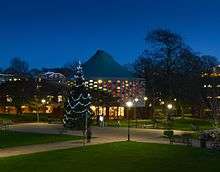
The current and fifth Chancellor of the university is Sanjeev Bhaskar, who succeeded Lord Attenborough in 2009.[23]
| Name of Chancellor | Period |
|---|---|
| The Viscount Monckton of Brenchley | 1961-65 |
| The Lord Shawcross | 1965-85 |
| The Duke of Richmond | 1985-98 |
| The Lord Attenborough | 1998-2009 |
| Sanjeev Bhaskar OBE | 2009-present |
The university has had seven Vice-Chancellors:
| Name of Vice-Chancellor | Period |
|---|---|
| John Fulton | 1961-67 |
| Asa Briggs | 1967-76 |
| Denys Wilkinson | 1976-87 |
| Leslie Fielding | 1987-92 |
| Gordon Conway | 1992-98 |
| Alasdair Smith | 1998-2007 |
| Michael Farthing | 2007-16 |
| Adam Tickell | 2016-Present |
Academic profile
Rankings
| ARWU[24] (2017, national) | 22-28 | |
|---|---|---|
| ARWU[25] (2017, world) | 201-300 | |
| QS[26] (2018, national) | 29 | |
| QS[27] (2018, world) | 187 | |
| THE[28] (2016/17, national) | 23 | |
| THE[29] (2016/17, world) | 149 | |
| CWTS Leiden[30] (2017, world) | 205 | |
| Complete[31] (2018, national) |
19 | |
| The Guardian[32] (2018, national) |
20 | |
| Times/Sunday Times[33] (2017, national) |
19 | |
The University of Sussex was ranked 62nd in Europe and 140th in the world by The Times Higher Education World University Rankings 2015/2016. The Academic Ranking of World Universities 2015 put the University of Sussex in the top 151–200 globally, while the university was ranked 187th in the world according to the QS World University Rankings 2016. Notably, the QS World University Rankings by Subject for 2016 placed the University of Sussex number two in the world for Development Studies, while it was ranked number one in the world for the same subject in 2015's instalment of the rankings.[34][35] Nationally, the University of Sussex is ranked among the top 20 universities by The Academic Ranking of World Universities, The Guardian and The Times/Sunday Times.
Research
The results of the Research Excellence Framework 2014 show that 98 per cent of research activity at Sussex is categorised as ‘world-leading’ (28 per cent), ‘internationally excellent’ (48 per cent) or ‘internationally recognised’ (22 per cent) in terms of originality, significance and rigour.[36] Sussex History was the highest rated History submission in the UK for the quality of its research outputs. The Sussex English submission rose from 31st to 9th across the UK since the last research assessment exercise in 2008. 84 per cent of the University’s research impact in Psychology was rated as the top possible grade, 4*. Sussex Geography had the most 4* rated research impact of any Geography submission across the UK.[37]
Student life
Housing
 Brighthelm
Brighthelm Swanborough
Swanborough East Slope
East Slope Lancaster House
Lancaster House Lewes Court
Lewes Court Park Village
Park Village Stanmer Court
Stanmer Court King's Road
King's Road York House
York House
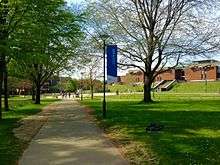
Accommodation on campus was expanded in the 1970s with the construction of the unusual split-level flats of East Slope. This development also has a social building with a porters' office and bar.
In the 1990s, as student numbers rose, further developments were constructed in the corner of campus between East Slope and Park Village. Brighthelm and Lewes Court were constructed in public-private partnership funding arrangements with the Bradford & Northern and Kelsey Housing Associations.
In total there are seven areas of student accommodation on campus. Two newer accommodation areas were completed recently: one next to Falmer railway station, named Stanmer Court, and the other next to East Slope, opposite Bramber House, known as Swanborough.[38]
The newest student residences, named Northfield, were constructed at the top end of campus, beyond Lewes Court, which opened in September 2011, with more planning to be opened by December 2013.[39]
Sport

The University competes in the following sports, usually with both men's and women's teams:
- Team sports: basketball, cricket, football, field hockey, Lacrosse, netball, American Football, rugby union, ultimate frisbee and volleyball.
- Racquet sports: Tennis, table tennis, badminton and squash.
- Individual sports: archery, fencing, swimming and trampolining.
- Outdoor pursuits: sailing, mountain biking, mountaineering, skiing and snowboarding, sub aqua, surfing and windsurfing.[40]
- Martial arts: mixed martial arts, kickboxing, Shaolin Kung Fu, aikido and sport aikido.[41]
Campus media
The Badger is the Union’s weekly newspaper and is written and designed entirely by Sussex students. It aims to represent the views and interests of students and communicate the work of the Union, as well as informing members about local, national and international issues that affect them as students.
University Radio Falmer was one of the first student radio stations in the country. It broadcasts to the world via the Internet.[42] The station has a busy daytime schedule and during the evening offers a range of genre programming, all from Sussex students. URF also runs a news service which is bound by legal regulations to remain neutral and unbiased. It won a bronze award in the best scripted programming category in the 2008 UK Student Radio Awards.[43]
"University of Sussex Student Television", abbreviated to UniTV is a student television channel, launched in September 2010. UniTV is a member of NaSTA (National Student Television Association) and has won 7 NaSTA awards in the past three years.
International students and opportunities
Of the 10,500 students at Sussex, around a quarter are international. Sussex has academic staff from over 50 countries and students from over 120 countries.
The University includes people from many different religious and cultural backgrounds, and there are several places for religious worship on campus.
English Language courses for speakers of other languages are provided by the Language Institute. "English in the Vacation" is intensive practice of spoken and written English. An International Foundation Year offered by the ISC offers routes directly to Sussex degrees.[44]
The International Summer School runs for four and eight weeks starting in July, providing intensive courses. It is predominantly attended by foreign students.[45] The ISS trips office provides excursions to prominent cities, theatres, and activities.[46]
Sussex students may also spend a year abroad as part of their degree in a variety of European institutions through the ERASMUS programme, as well as North America, Asia, Central & South America, Australia and North Africa.[47] Such study abroad opportunities are a result of the strong relationships Sussex has with a number of institutions including all campuses of the University of California.
Notable people
Notable alumni
.jpg)


 Rebeca Grynspan, Head of UN development
Rebeca Grynspan, Head of UN development
Notable staff
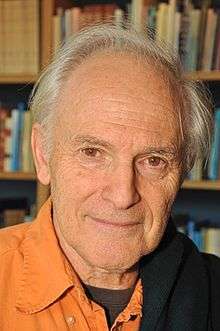 Harold Kroto, 1996 Nobel Prize in Chemistry
Harold Kroto, 1996 Nobel Prize in Chemistry Anthony Leggett, 2003 Nobel Prize in Physics
Anthony Leggett, 2003 Nobel Prize in Physics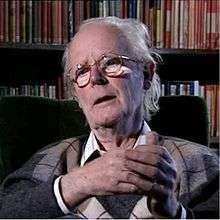 John Maynard Smith, 1999 Crafoord Prize
John Maynard Smith, 1999 Crafoord Prize
In the sciences Sussex counts among its past and present faculty five Nobel Prize winners: Sir Anthony Leggett,[48] Sir Paul Nurse,[49] Archer Martin,[50][51] Sir John Cornforth[52] and Sir Harry Kroto.[53] Sir Harry, the first Briton to win the chemistry prize in over ten years, received the prize in 1996 for the discovery of a new class of carbon compounds known as the fullerenes.
John Maynard Smith, FRS, founding father of Sussex Biology was honoured with the Crafoord Prize [54] and the Kyoto Prize[55] for his contributions to Evolutionary Biology.
The University has 15 Fellows of the Royal Society. These include Geoff Cloke (Inorganic Chemistry); Michael F. Land (Animal Vision - Frink Medal); Michael Lappert (Inorganic Chemistry); Alan Lehmann (Genetics and Genome Stability); John Murrell (Theoretical Chemistry); John Nixon (Inorganic Chemistry); Laurence Pearl (Structural Biology); Guy Richardson (Neuroscience).
In the arts, there are six members of faculty who have the distinction of being Fellows of the British Academy. Faculty staff publish around 3,000 papers, journal articles and books each year, as well as being involved in consultative work across the world. Former staff with FBAs include Donald Winch (economics).
Other prominent academics on the staff of the University have included; Geoffrey Bennington, the creator of the MA programme in Modern French Thought; Homi K. Bhabha (postcolonialism); Jonathan Dollimore (Renaissance literature, gender and queer studies); Katy Gardner (social anthropology); Gabriel Josipovici (Dante, the Bible); Jacqueline Rose (feminism, psychoanalysis); Nicholas Royle (modern literature and theory; deconstruction); Alan Sinfield (Shakespeare, sexuality, queer theory); Brian Street (anthropology); Gavin Ashenden (Senior Lecturer in English, University Chaplain, broadcaster and Chaplain to Her Majesty Queen Elizabeth II);[56] and Michael Lipton, shared winner of the 2012 Leontief Prize.
References
- ↑ "Financial Statements 2014-15" (PDF). University of Sussex. p. 29. Retrieved 29 February 2016.
- 1 2 "Financial Statements 2014-15" (PDF). University of Sussex. Retrieved 29 February 2016.
- 1 2 3 "2015/16 Students by HE provider, level, mode and domicile" (XLSX). Higher Education Statistics Agency. Retrieved 17 February 2017.
- ↑ "University of Sussex" (PDF). Guardian Unlimited. 1 May 2007. Retrieved 12 August 2007.
- 1 2 3 4 Carder, Tim. "University of Sussex - a potted history". Retrieved 12 August 2007.
- ↑ "University of Sussex - Academic Ranking of World Universities - 2016 - Shanghai Ranking - 2016". www.shanghairanking.com.
- ↑ http://www.sussex.ac.uk/history/about/historiansatsussex
- ↑ "News". The Badger Online. Retrieved 20 May 2012.
- ↑ "Official Crest on Vellum a". Imagelib.sussex.ac.uk. Retrieved 20 May 2012.
- ↑ "Press release archive : News and events : University of Sussex". University of Sussex. Retrieved 20 May 2012.
- ↑ "Shops, facilities and retail outlets". Brighton: University of Sussex. Retrieved 26 July 2011.
- 1 2 "About us". University of Sussex. Archived from the original on 4 March 2007. Retrieved 10 March 2007.
- ↑ "Areas of Outstanding Natural Beauty: Landscape Protection and Enhancement Aid Scheme (England)" (PDF). European Commission. Retrieved 12 August 2007.
- ↑ "The Gardner Arts Centre". Archived from the original on 8 February 2007. Retrieved 10 March 2007.
- ↑ "Gardner Arts Centre enters final season". University of Sussex. Retrieved 12 August 2007.
- ↑ The University of Sussex (1990, 1991). The University of Sussex Undergraduate Prospectus 1991 OCLC 50454932
- ↑ "Bulletin". University of Sussex. 20 July 2001.
- ↑ "Schools and Departments". University of Sussex. Retrieved 9 October 2009.
- ↑ University of Sussex (13 March 2012). "Two new heads of school to be appointed". The University of Sussex. Retrieved 16 July 2015.
- ↑ "Anthropology Goes Global", Sussex Anthropologist (newsletter), 1:1, Autumn 2009
- ↑ "International degree preparation - University of Sussex ISC". Sussex.ac.uk. 9 May 2012. Retrieved 20 May 2012.
- ↑ "BIMM Award Winning Music Colleges in Brighton, Bristol and Dublin". Bimm.co.uk. 2 March 2012. Retrieved 20 May 2012.
- ↑ "New Chancellor Announced". University of Sussex. Retrieved 20 May 2012.
- ↑ "Academic Ranking of World Universities 2017 - UK". Shanghai Ranking Consultancy. Retrieved 15 August 2017.
- ↑ "Academic Ranking of World Universities 2017". Shanghai Ranking Consultancy. Retrieved 15 August 2017.
- ↑ "QS World University Rankings 2018 - United Kingdom". Quacquarelli Symonds Ltd. Retrieved 8 June 2017.
- ↑ "QS World University Rankings 2018". Quacquarelli Symonds Ltd. Retrieved 8 June 2017.
- ↑ "World University Rankings 2016-17 - United Kingdom". Times Higher Education. Retrieved 21 September 2016.
- ↑ "World University Rankings 2016-17". Times Higher Education. Retrieved 21 September 2016.
- ↑ "CWTS Leiden Ranking 2017". CWTS Leiden Ranking 2017. Retrieved 19 May 2017.
- ↑ "University League Table 2018". The Complete University Guide. Retrieved 26 April 2017.
- ↑ "University league tables 2018". The Guardian. 16 May 2017. Retrieved 16 May 2017.
- ↑ "The Times and Sunday Times University Good University Guide 2017". Times Newspapers. Retrieved 23 September 2016.
- ↑ "QS World University Rankings by Subject 2016 - Development Studies". Top Universities. QS Quacquarelli Symonds. Retrieved 14 September 2016.
- ↑ "QS World University Rankings by Subject 2015 - Development Studies". Top Universities. QS Quacquarelli Symonds. Retrieved 14 September 2016.
- ↑ "Results & submissions : REF 2014 : View results and submissions by institution". results.ref.ac.uk.
- ↑ "Our research : Research at Sussex : University of Sussex". www.sussex.ac.uk.
- ↑ "At Home with US" (PDF). University of Sussex. Archived from the original (PDF) on 16 February 2007. Retrieved 14 March 2007.
- ↑ "Bulletin". University of Sussex. 9 October 2009. Retrieved 20 May 2012.
- ↑ http://www.bsus.org.uk
- ↑ "Integrated Martial Arts". Ussu.net. Retrieved 20 May 2012.
- ↑ "URF Online -". Retrieved 16 July 2015.
- ↑ "2008 Student Radio Awards". Archived from the original on 10 February 2009. Retrieved 26 January 2009.
- ↑ "International degree preparation - University of Sussex ISC". Studygroup.com. 9 May 2012. Retrieved 20 May 2012.
- ↑ http://www.sussex.ac.uk/iss/1-2.html Courses: International Summer School: University of Sussex Archived 1 February 2010 at the Wayback Machine.
- ↑ "Trips: International Summer School: University of Sussex". Archived from the original on 10 September 2010. Retrieved 20 May 2012.
- ↑ Web Team. "Destinations". Retrieved 16 July 2015.
- ↑ "Anthony J. Leggett". Nobelprize.org. Retrieved 18 May 2011.
- ↑ "Sir Paul M. Nurse". Nobelprize.org. Retrieved 18 May 2011.
- ↑ "Archer John Porter Martin". Nobelprize.org. Retrieved 18 May 2011.
- ↑ "Martin, Archer John Porter". Oxford Dictionary of National Biography (online ed.). Oxford University Press. doi:10.1093/ref:odnb/77176. (Subscription or UK public library membership required.)
- ↑ "John Warcup Cornforth". Nobelprize.org. Retrieved 18 May 2011.
- ↑ "Sir Harold W. Kroto". Nobelprize.org. Retrieved 18 May 2011.
- ↑ "Crafoord Prize 1999".
- ↑ "Japan's "Nobel Prize" for Sussex University biologist".
- ↑ "Rv Ca Dr Gavin Ashenden : School of English". University of Sussex. Retrieved 20 May 2012.
External links
| Wikimedia Commons has media related to University of Sussex. |
- University of Sussex website
- Brighton and Sussex Medical School
- University of Sussex Students' Union website
Coordinates: 50°51′55″N 0°05′08″W / 50.86528°N 0.08556°W